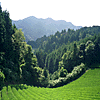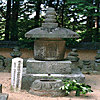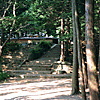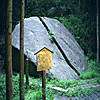A Visit to Yagyu Village
by Dave Lowry
(with photos by Diane Skoss)
Editor's note: When Meik, Steve Duncan, Yoko Sato, Tom Weckel, and I went on our pilgrimage to Yagyu-zato in July 1997, I took this chapter along (I was lucky enough to be able to read the book while it was still in manuscript) as a guide book. I'm delighted to be able to present portions of it now together with some of the photos we took along the way.
Yagyu-zato has not changed much in some ways, in the four intervening centuries since Munenori and Muneyoshi and the other famous masters of the Shinkage-ryu lived there. Now, as then, it is secluded, separated from Nara by dizzily pitched mountains and vertical ravines, accessible only by narrow roads that twist and switchback and meander--separated too, from the busy hustle of the big city. Yagyu-zato drowses, a hamlet of a few dozen houses, mom-and-pop stores, and a prefectural police box. A junior high school near the center of the village appears to be the only significant architectural addition to the town since the Tokugawa era.
 click on photo to see larger version
click on photo to see larger version
For centuries, the village of Yagyu was remarkable for little besides the fragrant teas cultivated on the precipitous slopes around it. Stonecutters chiseled into granite cliffs nearby. Tax collectors made the long journey to the hamlet regularly to levy their due in rice. Otherwise, the modest fief of the Yagyu clan was ignored. It may have remained that way forever, like a thousand other rural burgs just like it in Japan, were it not for the ambitious plans of the daimyo, Tokugawa Ieyasu. Ieyasu was the third of Japan's three stellar military leaders of the medieval age, and the last. Oda Nobunaga tried to rule through cunning and ruthlessness. Hideyoshi was a despot; intimidation was the metier of his power. Ieyasu's chosen path to becoming shogun was through the strategy of the bugeisha. He employed heiho, using the elements of battlefield strategy in making war as well as in his negotiations for peace. Tokugawa was, by turns, flexible and obstinate. He perfected balance while adroitly tripping up those who opposed him. Ieyasu bided his time through the closing decades of the sixteenth century, losing some battles, winning more. Always he kept his goal, to rule all of Japan, at the forefront of his strategic aims. In 1600, he was ready to have a go at it. Never one to overlook an advantage, the canny Ieyasu schemed to enlist all manner of ninja, mercenaries, militant priests, and hermit warrior-farmers into his forces. He chose the best recruiter he could find, for to the woodsy hills around Yagyu-zato such reclusive types naturally gravitated--and the hamlet's baron, Yagyu Muneyoshi, knew them all.
Through Muneyoshi's efforts, Ieyasu got his partisan troops. With their aid, he defeated all comers at the Battle of Sekigahara. He emerged the primogenitor of the Tokugawa line of shogun who would govern Japan for two hundred and fifty years, well into modern times. Yagyu Muneyoshi was granted an increase in his stipend. He received too, an invitation to the new shogun's capital in Edo, to demonstrate his martial skills.
Left to themselves in the countryside, the Yagyu clan had devoted themselves to the art of swordsmanship for many years, with an almost religious fervor. Muneyoshi was the first of his family to rise above the ranks of the average in terms of his bujutsu prowess. By his mid-thirties, Muneyoshi was widely regarded as the most accomplished martial artist in the whole region of Nara. In a challenge match with Kamiizumi Nobutsuna, though, Muneyoshi was so convincingly beaten that the only reason he escaped with his life was because Nobutsuna was wielding a weapon of split bamboo encased in leather rather than a real sword or bokken. Nobutsuna was a legendary master of the Kage-ryu; his inspirations into the craft of swordsmanship had, in part, led him to found a "new" or Shin-kage-ryu. Upon Muneyoshi's defeat, he became Nobutsuna's disciple. Muneyoshi was eventually initiated into the okuden, the deepest teachings of Nobutsuna's ryu. The Yagyu warrior in turn, devoted himself to the further development of the Shinkage tradition. He taught his own children, including a particularly adept son, Munenori....
The salient characteristic of the Yagyu Shinkage-ryu is that it seeks to teach the bugeisha to attain victory by penetrating into the opponent's mind. Through various exercises that are an integral part of its curriculum and by constant training, the Shinkage-ryu swordsman learns to "read" the intentions of an adversary and to respond a split instant before those intentions are realized. In less philosophical, more practical terms, this means that it is not until the oncoming strike is unleashed or the opponent's evasion against him already committed that the Shinkage-ryu exponent acts. Timing is critical. Correct distancing is essential. A fraction too early or too late, a hairsbreadth too near or too far, and it is death for certain....
The first stop for me in Yagyu village, so my obasan guide had insisted, was at Hotokuji, the Hotoku Temple. She gave me directions to get there that I did not need. From my sensei I had heard stories about this place, had read about it, since I was a child. I could have gotten to Hotokuji blindfolded. I walked through the village and turned left at the sound of the gushing brook that ran through the middle of the village. A plank bridge led over the stream. The trail, on the far side, was as steep as the one that led up to the Genyokan Dojo and even older, looped up the mountain's shoulder. The path was cobblestone, the stones dark buns, polished slippery by the rain. They had been laid so many years ago it seemed the path was almost a part of the terrain. It led me through bamboo thickets with stalks two stories tall, and then into an evergreen forest, switchbacking upward, offering intermittent glimpses of the village below and of more mountains off in the distance, long beards of mist hanging like gauzy curtains between their peaks.
Hotokuji is a repository of the Yagyu past. I had it to myself, except for a couple of attendant priests who were content to sit in their office drinking tea and watching a sumo tournament on their little Sony. I strolled between glass-topped cases in one hall of the temple that had been converted into a museum. It is always nice to have such places to oneself, particularly so in Japan where museums, public gardens, and historical sites can often be found just by listening for the gabbling crowds and squawking informational recordings that play on endlessly. Armor was on display--helmets and lacquered breastplates, a saddle and stirrups, all heirlooms of the Yagyu family, all emblazoned with the distinctive crest of the family, a stylised depiction of a pair of jingasa, broad-brimmed woven reed hats. There were rows of tsuba, or handguards fitted atop the hilt of katana, forged by Yagyu Hyogonosuke Renya Taira no Toshikane, the fifth headmaster of the Yagyu school.
Yagyu Toshikane was so fearsomely demanding of himself as a craftsman that he was rumored to have made a practice of tossing his newly forged guards into a cask and pounding them with a mallet. Those that came out of the cask unblemished were judged by him to be worthy for use. Today, the characteristic "wet copper" look of these tsuba are, as I said, gems among collectors of Japanese swords and sword furniture. To stand over a case with more than a dozen of them on display in one place, by far the largest example of Toshikane's ouvre, was mind-boggling.
Inside the glass cases at Hotokuji, too, were examples of the densho, the handwritten scrolls containing the teachings and many of the secret principles of the Shinkage-ryu. Spidery, ink-brushed figures illustrated the scrolls, brandishing their swords in the various postures of the ryu. It occurred to me that they had been drawn by swordsmen to illustrate theories of combat that were weighted with the actual experience of dealing life and death with the sword. There were also careful diagrams instructing in the proper situating of a house or castle to protect it against attack from an enemy or from the elements, and arcane formulae of esoteric mikkyo lore for predicting weather conditions that would be favorable to battle. Matters my sensei had mentioned only briefly or in passing, I could read about in these scrolls, and I shook my head in wonderment at the depths of the traditions that were still left for me to explore.
At the main altar of Hotokuji presided a wooden effigy of Yagyu Munenori, stern and severe in his expression. Munenori could stun sparrows in the hedges with his shout. He could slice solid oak tree limbs with the edge of a dull wooden practice blade more cleanly than other men could cut through those branches with a weapon of sharp steel. Less fabulously, Munenori is revered for his philosophical contributions to the way of the warrior, particularly for the flavor of Zen that he stirred into the pot of the Japanese martial arts.
Early on in his career Munenori, already a master bugeisha, came under the influences of one of Japan's true characters, the Zen Buddhist prelate, Takuan Soho. Takuan was an eccentric, an iconoclast of the first order. When he met Munenori in 1632, he was, primarily because of those very traits in his personality, in serious trouble with the second shogun of the Tokugawa line, Tokugawa Hidetada. Hidetada had banished Takuan (at that time an abbot of the Daitokuji Temple) for Takuan's complaints about what he considered meddling by the shogun and his officials in temple affairs. Munenori used his status and position as Hidetada's fencing master to intervene in the matter. Eventually, Takuan's banishment was lifted. Under Hidetada's successor, Tokugawa Iemitsu, Takuan's star rose again and ascended even higher. The priest mingled with nobility, with daimyo, and wealthy merchants, and the great scholars and artists of his age. He and Munenori developed a special relationship as Zen master and disciple.
 click on photo to see larger version
click on photo to see larger version
Yagyu Munenori's grave is secluded on a knoll behind the Hotoku Temple. The stone marking it is carved in the shape of a memorial tablet resting atop a turtle's shell. It is in the center of a diminutive walled plot, one crowded with the headstones of other members of the Yagyu clan. All around the cemetery, towering stalks of green bamboo rustled and dripped; cryptomeria boughs creaked in the wind like rusted hinges. The grave markers were all encrusted with lichens. The flat surfaces of Munenori's stone were dappled with copper coins left as offerings, donations that were used in the upkeep of the grounds. I added my own and bowed....
 click on photo to see larger version
click on photo to see larger version
A covey of curious private school girls surrounded me as I was leaving the grounds of Hotokuji. They were off on one of those innumerable school trips that Japanese students seem to be taking all over the country, all year long. We posed for pictures of each other at the temple gate, then walked together the short distance down the slope to the Masakisaka kendo dojo. The practice hall was empty. In the evening, its walls would resound with the war cries of young kendoka and with the racketing clatter of their bamboo weapons. Kendo is a frightfully rigorous form of budo, what with the perspiring under the heavy mask and armor, accepting without complaint the full force strikes that accidentally yet regularly find unprotected areas. Still, if one is going to follow it as a budo, could there be a more satisfying place in which to train? I was envious of the members of the Masakisaka dojo, practicing on this mountainside above the village of Yagyu, so close to the resting place of the most famous swordsmen of old Japan.
The rugged hills around Yagyu-zato are criss-crossed by narrow footpaths that ribbon into the woods, traversed once by farmers and--maybe, if the stories are true--by some of those sinister types who pledged their clandestine services to the shogun at Muneyoshi's bidding, at the battle of Sekigahara. The schoolgirls and I parted company, they back to the main part of the village while I turned up one of the woodsy trails, one marked by a weathered, hand-lettered sign. It led me out past terraces of tea bushes and through the portals of a Shinto torii. The tea bushes gave way to more forest. The trees closed in all around, became deeper and denser the further I walked. The evergreen canopy had not yet lost its thick foliage to the season. The only other place I have ever been in a darker forest was in the coniferous woods of Maine. The quality of the shade was adumbral--heavy. Sounds were muffled. There was a brief gap in the denseness as I came around a corner and there, sitting in a clearing, was a boulder shaped like an egg, a few feet taller than me and twice as long. It was granite, split neatly in halves. Myth has it that one moonless night Yagyu Muneyoshi was strolling along the very path I'd taken, his way lit only by the lightning from a storm. He was blocked by a tengu that flew down with a wild rustling of wings, spoiling for a fight.
Tengu are Japanese goblins. They have played a significant role in the traditions of many of the schools of classical martial arts, including the Shinkage-ryu. Tengu have wings and clawed feet and in that sense, they are portrayed as bird-like. Some have enormous, phallic noses; others have sharp hooked beaks. Tengu, though, are supposed to have the arms and bodies of men, and the capacity for speech, if they feel like talking. They do not always. They are said to be a cantankerous lot, and changeable in their nature. They invariably haunt the most inaccessible reaches of the mountains, far from human habitation... not too far, however, because according to the country folk of old Japan, tengu were often to blame for rock slides that came tumbling down without warning, for torrents that washed away rice paddies, for all sorts of mischief. And many a farmer or woodcutter caught out late on the mountain trails would later swear he'd been stalked by a tengu, flitting silently in the black branches above him, frightening him into running for his very life.
Tengu are feisty demons, yet as I said, they are of a capricious nature. Sometimes they seem to take a benign interest in humans, especially in ascetic bugeisha who secluded themselves in alpine tengu territory in order to protect their art. Yoshitsune, the boy-general of the Minamoto clan, was taught the art of fencing by tengu. Several koryu credit the supernatural intercession of tengu as the source of their school's martial principles. Bugeisha of both the Kage and the Shinkage traditions once encountered these goblins, their lore has it, and in both cases miraculous techniques were imparted, methods with the sword that had never been seen before. One whole section of the kata of the Shinkage-ryu are called the tengusho. The tengu who drew his blade against Muneyoshi that stormy night was no goblinish sensei, though. Not according to the story that has grown up to explain the split boulder. He wanted a fight. Muneyoshi gave it to him. The tale has it that villagers down the mountain in Yagyu-zato could hear the clashing of the katana of the two fighters, the roar of the beaked tengu mixed with the gunshot bark of Muneyoshi's kiai. The duel was an epic one, a Japanese Beowulf and Grendel. At its climax, Muneyoshi uncorked a ferocious whack that would have sent his weapon right through the tengu--had not the crafty goblin executed a nimble dodge. The swordsman struck instead the boulder that has been called ever afterward, the itto seki, the "single stroke sword rock," cleaved by a force so enormous that the explosion it made that night, if you stand alone in the clearing where the rock is, seems still to echo along the valleys and gorges all around.
 click on photo to see larger version
click on photo to see larger version
Presented with kind permission of the author. All rights reserved.
Other books and chapters by Dave Lowry
More articles by Dave Lowry at Koryu.com
Read a review of this book, (and consider purchasing a copy, while you're at it). You might also be interested in the series of letters from the Zen priest Takuan to Yagyu Munenori. W.S. Wilson has done a wonderful translation of these in his The Unfettered Mind. Finally, learn more about Yagyu family heiho in The Life-Giving Sword (translated by William Scott Wilson) and the Sword & the Mind, another translation of the Heiho Kadensho, by Hiroaki Sato.

Contact Koryu.com
Last modified on December 27, 2017
URL: https://koryu.com /library/dlowry2.html
Copyright ©2022 Koryu Books. All rights reserved.
